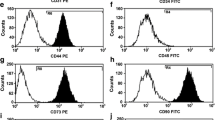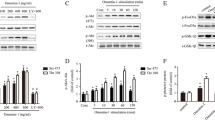Abstract
Low-level laser therapy (LLLT) has been shown to increase the proliferation of several cell types. We evaluated the effects of LLLT on adhesion, proliferation, and gene expression of vascular endothelial growth factor (VEGF) and type 2 receptor of VEGF (VEGFR2) at mesenchymal stem cells (MSCs) from human (hMSCs) and rat (rMSCs) adipose tissues on nutritional deficiencies. A dose-response curve was performed with cells treated with laser Ga-Al-As (660 nm, 30 mW) at energy of 0.7 to 9 J. Cell adhesion and proliferation were quantified 20, 40, and 60 min after LLLT and 24, 72, and 120 h after cultivation. Gene expression was verified by RT-PCR after 2 h of LLLT. A minor nutritional support caused a significant decrease in proliferation and adhesion of hMSCs and rMSCs. However, at the lowest LLLT dose (0.7 J), we observed a higher proliferation in hMSCs at standard condition shortly after irradiation (24 h). Adhesion was higher in hMSCs cultivated in controlled conditions at higher LLLT doses (3 and 9 J), and rMSCs show a reduction in the adhesion on 1.5 to 9 J. On nutritional deprivation, a 9 J dose was shown to reduce proliferation with 24 h and adhesion to all culture times in rMSCs. VEGF and VEGFR2 were increased after LLLT in both cell types. However, hMSCs under nutritional deprivation showed higher expression of VEGF and its receptor after irradiation with other laser doses. In conclusion, LLLT on human and rat MSCs might upregulate VEGF messenger RNA (mRNA) expression and modulate cell adhesion and proliferation distinctively.



Similar content being viewed by others
References
Wagner W, Ho AD (2007) Mesenchymal stem cell preparations—comparing apples and oranges. Stem Cell Rev 3:239–248
Caplan AI (1991) Mesenchymal stem cells. J Orthop Res 9:641–650
Dominici M, Le Blanc K, Mueller I et al (2006) Minimal criteria for defining multipotent mesenchymal stromal cells. The international society for cellular therapy position statement. Cytotherapy 8:315–317
Kuznetsov SA, Krebsbach PH, Satomura K et al (1997) Single-colony derived strains of human marron stromal fibroblasts form bone after transplantation in vivo. J Bone Miner Res 12:1335–1347
Gronthos S, Mankani M, Brahim J et al (2000) Postnatal human dental pulp stem cells (DPSCs) in vitro and in vivo. Proc Natl Acad Sci U S A 97:13625–13630
Eduardo FP, Bueno DF, Freitas PM et al (2008) Stem cell proliferation under low intensity laser irradiation: a preliminary study. Laser Med Surg 40:433–438
Secco M, Zucconi E, Vieira NM et al (2008) Multipotent stem cells from umbilical cord: cord is richer than blood. Stem Cells 26:146–150
Zuk PA, Zhu M, Ashjian P et al (2002) Human adipose tissue is a source of multipotent stem cells. Mol Biol Cell 13:4279–4295
Gimble JM, Katz AJ, Bunnell BA (2007) Adipose-derived stem cells for regenerative medicine. Circ Res 100:1249–1260
Stocum DL (2001) Stem cells in regenerative biology and medicine. Wound Repair Regen 9:429–442
Mummery CL, Davis RP, Krieger JE (2010) Challenges in using stem cells for cardiac repair. Sci Transl Med 2:27 ps17
Tuby H, Maltz L, Oron U (2009) Implantation of low-level laser irradiated mesenchymal stem cells into the infracted rat heart is associated with reduction in infarct size and enhanced angiogenesis. Photomed Laser Surg 27:227–233
Bai X, Alt E (2010) Myocardial regeneration potential of adipose tissue-derived stem cells. Biochem Biophys Res Commun 401:321–326
Mirsky N, Krispel Y, Shoshany Y et al (2002) Promotion of angiogenesis by low energy laser irradiation. Antioxid Redox Signal 4:785–790
Danoviz ME, Nakamuta JS, Marques FLN et al (2010) Rat adipose tissue-derived stem cells transplantation attenuates cardiac dysfunction post-infarction and biopolymers enhance cell retention. PLoS One 5:e12077
Ferraresi C, Hamblin MR, Parizotto NA (2012) Low-level laser (light) therapy (LLLT) on muscle tissue: performance, fatigue and repair benefited by the power of light. Photonics Lasers Med 1:267–286
Tuby H, Maltz L, Oron U (2006) Modulations of VEGF and iNOS in the rat heart by low level laser therapy are associated with cardioprotection and enhanced angiogenesis. Lasers Surg Med 38:682–688
Tuby H, Maltz L, Oron U (2007) Low-level laser irradiation (LLLI) promotes proliferation of mesenchymal and cardiac stem cells in culture. Lasers Surg Med 39:373–378
Tuby H, Maltz L, Oron U (2011) Induction of autologous mesenchymal stem cells in the bone marrow by low-level laser therapy has profound beneficial effects on the infarcted rat heart. Lasers Surg Med 43:401–409
Danoviz ME, Bassaneze V, Nakamuta JS et al (2011) Adipose tissue-derived stem cells from humans and mice differ in proliferation capacity and genome stability in long-term cultures. Stem Cells Dev 20:661–670
Bassaneze V, Barauna VG, Lavini-Ramos C et al (2010) Shear stress induces nitric oxide-mediates vascular endothelial growth factor production in human adipose tissue mesenchymal stem cells. Stem Cells Dev 19:371–378
Blande IS, Bassaneze V, Lavini-Ramos C et al (2009) Adipose tissue mesenchymal stem cell expansion in animal serum-free medium supplemented with autologous human platelet lysate. Transfusion 49:2680–2685
Mvula B, Mathope T, Moore T et al (2010) Effect of low-level laser irradiation and epidermal growth factor on adult human adipose-derived stem cells. Lasers Med Sci 25:33–39
Colter DC, Sekiya I, Prockop DJ (2001) Identification of a subpopulation of rapidly self-renewing and multipotential adult stem cells in colonies of human marrow stromal cells. Proc Natl Acad Sci U S A 98:7841–7845
Mesquita-Ferrari RA, Ribeiro R, Souza NH et al (2011) No effect of low-level lasers on in vitro myoblast culture. Indian J Exp Biol 49:423–428
Mosmann T (1983) Rapid colorimetric assay for cellular growth and survival: application to proliferation and cytotoxicity assays. J Immunol Methods 65:55–63
Löster K, Horstkorte R (2000) Enzymatic quantification of cell-matrix and cell-cell adhesion. Micron 31:41–53
Ferreira MPP, Ferrari RAM, Gravalos ED et al (2009) Effect of low-energy gallium-aluminum-arsenide and aluminium gallium indium phosphide laser irradiation on the viability of C2C12 myoblasts in a muscle injury model. Photomed Laser Surg 27:901–906
Mvula B, Mathope T, Moore T et al (2008) The effect of low level laser irradiation on adult human adipose derived stem cells. Lasers Med Sci 23:277–282
Carrancio S, López-Holgado N, Sánchez-Guijo FM et al (2008) Optimization of mesenchymal stem cell expansion procedures by cell separation and culture conditions modification. Exp Hematol 36:1014–1021
Anwer AG, Gosnell ME, Perinchery SM et al (2012) Visible 532 nm laser irradiation of human adipose tissue-derived stem cells: effect on proliferation rates, mitochondria membrane potential and autofluorescence. Lasers Surg Med 44:769–778
Zhang H, Hou JF, Shen Y et al (2010) Low level laser irradiation precondition to create friendly milieu of infarcted myocardium and enhance early survival of transplanted bone marrow cells. J Cell Mol Med 14:1975–1987
Kim H, Choi K, Kweon OK et al (2012) Enhanced wound healing effect of canine adipose-derived mesenchymal stem cells with low-level laser therapy in athymic mice. J Dermatol Sci 68:149–156
Hou JF, Zhang H, Yuan X et al (2008) In vitro effects of low-level laser irradiation for bone marrow mesenchymal stem cells: proliferation, growth factors secretion and myogenic differentiation. Lasers Surg Med 40:726–733
Author information
Authors and Affiliations
Corresponding author
Rights and permissions
About this article
Cite this article
de Oliveira, T.S., Serra, A.J., Manchini, M.T. et al. Effects of low level laser therapy on attachment, proliferation, and gene expression of VEGF and VEGF receptor 2 of adipocyte-derived mesenchymal stem cells cultivated under nutritional deficiency. Lasers Med Sci 30, 217–223 (2015). https://doi.org/10.1007/s10103-014-1646-9
Received:
Accepted:
Published:
Issue Date:
DOI: https://doi.org/10.1007/s10103-014-1646-9




